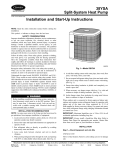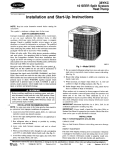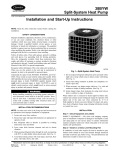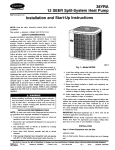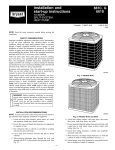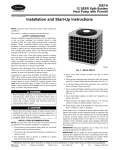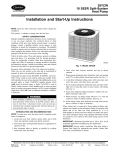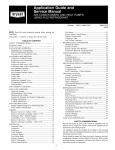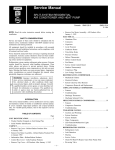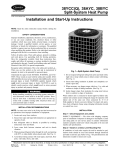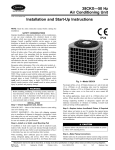Download Carrier 38AYC Instruction manual
Transcript
38AYC 11 SEER Split System Heat Pump Visit www.carrier.com Installation and Start-Up Instructions NOTE: Read the entire instruction manual before starting the installation. This symbol → indicates a change since the last issue. SAFETY CONSIDERATIONS Improper installation, adjustment, alteration, service, maintenance, or use can cause explosion, fire, electrical shock, or other conditions which may cause death, personal injury, or property damage. Consult a qualified installer, service agency, or your distributor or branch for information or assistance. The qualified installer or agency must use factory-authorized kits or accessories when modifying this product. Refer to the individual instructions packaged with the kits or accessories when installing. Follow all safety codes. Wear safety glasses, protective clothing, and work gloves. Use quenching cloth for brazing operations. Have fire extinguisher available. Read these instructions thoroughly and follow all warnings or cautions included in literature and attached to the unit. Consult local building codes and National Electrical Code (NEC) for special requirements. Recognize safety information. This is the safety-alert symbol . When you see this symbol on the unit and in instructions or manuals, be alert to the potential for personal injury. Understand the signal words DANGER, WARNING, and CAUTION. These words are used with the safety-alert symbol. DANGER identifies the most serious hazards which will result in severe personal injury or death. WARNING signifies hazards which could result in personal injury or death. CAUTION is used to identify unsafe practices which would result in minor personal injury or product and property damage. Before installing, modifying, or servicing system, main electrical disconnect switch must be in the OFF position. There may be more than 1 disconnect switch. Lock out and tag switch with a suitable warning label. Electrical shock can cause personal injury or death. → A97005 Fig. 1—Model 38AYC 7. Do not suspend refrigerant tubing from joists and studs with a rigid wire or strap which comes in direct contact with tubing. (See Fig. 2.) 8. Ensure that tubing insulation is pliable and completely surrounds vapor tube. 9. When necessary, use hanger straps which are 1 in. wide and conform to shape of tubing insulation. (See Fig. 2.) 10. Isolate hanger straps from insulation by using metal sleeves bent to conform to shape of insulation. INSTALLATION RECOMMENDATIONS NOTE: In some cases noise in the living area has been traced to gas pulsations from improper installation of equipment. When outdoor unit is connected to factory-approved indoor unit, outdoor unit contains system refrigerant charge for operation with indoor unit of the same size when connected by 15 ft of field-supplied or factory accessory tubing. For proper unit operation, check refrigerant charge using charging information located on control box cover and/or in the Check Charge section of this instruction. 1. Locate unit away from windows, patios, decks, etc. where unit operation sounds may disturb customer. IMPORTANT: Maximum liquid-line size is 3/8-in. OD for all residential applications including long line. 2. Ensure that vapor and liquid tube diameters are appropriate to capacity of unit. IMPORTANT: Always install a liquid-line filter drier. Refer to Product Data Digest for appropriate part number. Obtain filter drier from your distributor or branch. 3. Run refrigerant tubes as directly as possible by avoiding unnecessary turns and bends. INSTALLATION 4. Leave some slack between structure and unit to absorb vibration. Step 1—Check Equipment and Job Site 5. When passing refrigerant tubes through the wall, seal opening with RTV or other pliable silicon-based caulk. (See Fig. 2.) UNPACK UNIT 6. Avoid direct tubing contact with water pipes, duct work, floor joists, wall studs, floors, and walls. Move to final location. Remove carton taking care not to damage unit. Manufacturer reserves the right to discontinue, or change at any time, specifications or designs without notice and without incurring obligations. Book 1 4 PC 101 Catalog No. 563-852 Printed in U.S.A. Form 38AYC-2SI Pg 1 10-97 Replaces: 38AYC-1SI/38-6SM Tab 5a 5a NOTE: Avoid contact between tubing and structure OUTDOOR WALL INDOOR WALL CAULK LIQUID TUBE C VAPOR TUBE INSULATION THROUGH THE WALL JOIST HANGER STRAP (AROUND VAPOR TUBE ONLY) 3⁄8″D. (9.53) TIEDOWN INSULATION VAPOR TUBE KNOCKOUTS (2) PLACES A B A94199 Dimensions (In.) MINIMUM TIEDOWN KNOCKOUT LOCATIONS MOUNTING PAD A B C DIMENSIONS 018 22-1/2 X 22-1/2 3-11/16 18-1/8 14-3/8 024–060 30 X 30 6-1/2 23-1/2 20 1″ MIN. UNIT SIZE LIQUID TUBE SUSPENSION A94028 Fig. 2—Connecting Tubing Installation Fig. 3—Mounting Unit to Pad INSPECT EQUIPMENT File claim with shipping company prior to installation if shipment is damaged or incomplete. Locate unit rating plate on unit service panel. It contains information needed to properly install unit. Check rating plate to be sure unit matches job specifications. → Step 2—Install on a Solid, Level Mounting Pad If conditions or local codes require the unit be attached to pad, tie down bolts should be used and fastened through knockouts provided in unit base pan. Refer to unit mounting pattern in Fig. 3 to determine base pan size and knockout hole location. On rooftop applications, mount on level platform or frame. Place unit above a load-bearing wall and isolate unit and tubing set from structure. Arrange supporting members to adequately support unit and minimize transmission of vibration to building. Consult local codes governing rooftop applications. Roof-mounted units exposed to winds above 5 mph may require wind baffles to achieve adequate defrost. Consult Low-Ambient Guideline for wind baffle construction. NOTE: Unit must be level to within ± 2° (± 3/8 in./ft) per compressor manufacturer specifications. → Step 3—Clearance Requirements When installing, allow sufficient space for airflow clearance, wiring, refrigerant piping, and service. Allow 30-in. clearance to service end of unit and 48 in. above unit. For proper airflow, a 6-in. clearance on 1 side of unit and 12 in. on all remaining sides must be maintained. Maintain a distance of 24 in. between units. Position so water, snow, or ice from roof or eaves cannot fall directly on unit. On rooftop applications, locate unit at least 6 in. above roof surface. Step 4—Operating Ambients The minimum outdoor operating ambient in cooling mode is 55°F, and the maximum outdoor operating ambient in cooling mode is 125°F. The maximum outdoor operating ambient in heating mode is 66°F. Step 5—Elevate Unit Accumulation of water and ice in base pan may cause equipment damage. In areas where prolonged freezing temperatures are encountered, elevate unit per local climate and code requirements to provide clearance above estimated snowfall level and ensure adequate drainage of unit. → Step 6—Check Indoor and Outdoor AccuRater® Piston Check indoor coil piston to see if it matches the required piston shown on outdoor unit rating plate. If it does not match, replace indoor coil piston with piston shipped with outdoor unit. The piston shipped with outdoor unit is correct for any approved indoor coil combination. Remove indoor coil piston if unit is to be installed on system with a TXV metering device. Check outdoor unit piston as follows: 1. Remove cap and retainer holding outdoor piston in liquid service valve. 2. Remove outdoor piston and check size with matching number on unit rating plate. 3. After verifying size, reinstall piston and retainer. If O-ring is damaged during removal, install new retainer. 2 → Step 7—Check Defrost Thermostat Step 8—Make Piping Connections Check defrost thermostat to ensure it is properly located and securely attached. There is a liquid header with a brass distributor and feeder tube going into outdoor coil. At the end of 1 of the feeder tubes, there is a 3/8-in. OD stub tube approximately 2 in. long. (See Fig. 4.) The defrost thermostat should be located on stub tube. Note that there is only 1 stub tube used with liquid header, and on most units it is the bottom circuit. Relieve pressure and recover all refrigerant before system repair or final unit disposal to avoid personal injury or death. Use all service ports and open all flow-control devices, including solenoid valves. FEEDER TUBE → STUB TUBE If ANY refrigerant tubing is buried, provide a 6-in. vertical rise at service valve. Refrigerant tubing lengths up to 36 in. may be buried without further special consideration. For lengths above 36 in., refer to Residential Split System Buried-Line Application Guideline. To prevent damage to unit or service valves observe the following: • Use a brazing shield. • Wrap service valves with wet cloth or use a heat sink material. DEFROST THERMOSTAT → Outdoor units may be connected to indoor section using accessory A97517 Fig. 4—Defrost Thermostat Location tubing package or field-supplied refrigerant grade tubing of correct size and condition. For tubing requirements beyond 50 ft, substantial capacity and performance losses can occur. Following the recommendations in the Residential Split System Long-Line Application Guideline will reduce these losses. Refer to Table 1 for field tubing diameters. Refer to Table 2 for accessory requirements. → Table 1—Refrigerant Connections and Recommended Liquid and Vapor Tube Diameters (In.) UNIT SIZE 018 024 030, 036 042 048, 060 LIQUID Connection Diameter 3/8 3/8 3/8 3/8 3/8 Tube Diameter 3/8 3/8 3/8 3/8 3/8 VAPOR Connection Diameter 5/8 3/4 3/4 7/8 7/8 Tube Diameter 5/8 3/4 3/4 7/8 1-1/8 VAPOR (LONG LINE) Tube Diameter 3/4 3/4 7/8 1-1/8 1-1/8 NOTES: 1. Tube diameters are for lengths up to 50 ft. For tubing lengths greater than 50 ft, consult Residential Split System Long-Line Application Guideline. 2. Do not apply capillary tube indoor coils to these units. → Table 2—Accessory Usage ACCESSORY Crankcase Heater Evaporator Freeze Thermostat Accumulator Compressor Start Assist Capacitor and Relay Low-Ambient Controller, MotorMaster® Control, or Low-Ambient Pressure Switch Wind Baffle Unit Risers Liquid-Line Solenoid Valve or Hard Shutoff TXV Ball Bearing Fan Motor REQUIRED FOR LOW-AMBIENT APPLICATIONS (BELOW 55°F) Yes Yes No REQUIRED FOR LONG-LINE APPLICATIONS* (OVER 50 FT) Yes No No REQUIRED FOR BURIED-LINE APPLICATIONS† (OVER 3 FT) Yes No Yes Yes Yes Yes Yes No No See Low-Ambient Instructions Recommended No No No No No See Long-Line Application Guideline Yes Yes‡ No No * For tubing line sets between 50 and 175 ft, refer to Residential Split System Long-Line Application Guideline. † For buried line applications, refer to Residential Split System Buried-Line Application Guideline. ‡ Required for Low-Ambient Controller (full modulation feature) and MotorMaster Control only. 3 → For buried-line applications greater than 36 in., refer to Table 2 attention to feeder tubes, making sure wire ties on feeder tubes are secure and tight. and Residential Split System Buried-Line Application Guideline. Step 9—Make Electrical Connections If refrigerant tubes or indoor coil are exposed to atmosphere, they must be evacuated to 500 microns to eliminate contamination and moisture in the system. OUTDOOR UNIT CONNECTED TO FACTORY-APPROVED INDOOR UNIT To avoid personal injury or death, do not supply power to unit with compressor terminal box cover removed. Outdoor unit contains correct system refrigerant charge for operation with indoor unit of same size when connected by 15 ft of field-supplied or factory-accessory tubing. Check refrigerant charge for maximum efficiency. Be sure field wiring complies with local and national fire, safety, and electrical codes, and voltage to system is within limits shown on unit rating plate. Contact local power company for correction of improper voltage. See unit rating plate for recommended circuit protection device. NOTE: Operation of unit on improper line voltage constitutes abuse and could affect unit reliability. See unit rating plate. Do not install unit in system where voltage may fluctuate above or below permissible limits. NOTE: Use copper wire only between disconnect switch and unit. NOTE: Install branch circuit disconnect of adequate size per NEC to handle unit starting current. Locate disconnect within sight from and readily accessible from unit, per Section 440-14 of NEC. REFRIGERANT TUBING Connect tubing to fittings on outdoor unit vapor and liquid service valves. (See Table 1.) Use refrigerant grade tubing. SWEAT CONNECTION To avoid valve damage while brazing, service valves must be wrapped in a heat-sinking material such as a wet cloth. 1. Remove plastic retainer holding outdoor piston in liquid service valve. ROUTE GROUND AND POWER WIRES 2. Locate adapter tube shipped with unit. Remove access panel to gain access to unit wiring. Extend wires from disconnect through power wiring hole provided and into unit control box. 3. Install strainer in adapter tube and connect tube to service valve. (See Fig. 5.) 4. Connect refrigerant tubing to fittings on outdoor unit vapor and liquid service valves. The unit cabinet must have an uninterrupted or unbroken ground to minimize personal injury if an electrical fault should occur. The ground may consist of electrical wire or metal conduit when installed in accordance with existing electrical codes. Failure to follow this warning can result in an electric shock, fire, or death. 5. Service valves are closed from factory and ready for brazing. After wrapping service valve with a wet cloth, tubing set can be brazed to service valve using either silver bearing or non-silver bearing brazing material. Consult local code requirements. Refrigerant tubing and indoor coil are now ready for leak testing. This check should include all field and factory joints. CONNECT GROUND AND POWER WIRES Connect ground wire to ground connection in control box for safety. Connect power wiring to contactor as shown in Fig. 6. PISTON BODY DISCONNECT PER N. E. C. AND/OR LOCAL CODES CONTACTOR FIELD POWER WIRING PISTON PISTON RETAINER FIELD GROUND WIRING STRAINER GROUND LUG A91056 Fig. 6—Line Power Connections CONNECT CONTROL WIRING Route 24-v control wires through control wiring grommet and connect leads to control wiring. (See Fig. 7–11.) Refer also to Installation Instructions packaged with thermostat. SWEAT/FLARE ADAPTER → Fig. 5—Liquid Service Valve A97512 Use No. 18 AWG color-coded, insulated (35°C minimum) wire. If thermostat is located more than 100 ft from unit, as measured along the control voltage wires, use No. 16 AWG color-coded wire to avoid excessive voltage drop. → FINAL TUBING CHECK IMPORTANT: Check to be certain factory tubing on both indoor and outdoor unit has not shifted during shipment. Ensure tubes are not rubbing against each other or any sheet metal. Pay close → All wiring must be NEC Class 1 and must be separated from incoming power leads. 4 Use furnace transformer, fan coil transformer, or accessory transformer for control power, 24-v/40-va minimum. With power supplied to indoor and outdoor units, transformer is energized. NOTE: Use of available 24-v accessories may exceed the minimum 40-va power requirement. Determine total transformer loading and increase the transformer capacity or split the load with an accessory transformer as required. Cooling On a call for cooling, thermostat makes circuits R-O, R-Y, and R-G. Circuit R-O energizes reversing valve, switching it to cooling position. Circuit R-Y energizes contactor, starting outdoor fan motor and compressor circuit. R-G energizes indoor unit blower relay, starting indoor blower motor on high speed. → FINAL WIRING CHECK IMPORTANT: Check factory wiring and field wire connections to ensure terminations are secured properly. Check wire routing to ensure wires are not in contact with tubing, sheet metal, etc. When thermostat is satisfied, its contacts open, de-energizing the contactor and blower relay. Compressor and motors should stop. → Step 10—Compressor Crankcase Heater NOTE: If indoor unit is equipped with a time-delay relay circuit, the blower runs an additional 90 sec to increase system efficiency. When equipped with a crankcase heater, furnish power to heater a minimum of 24 hr before starting unit. To furnish power to heater only, set thermostat to OFF and close electrical disconnect to outdoor unit. A crankcase heater is required if refrigerant tubing is longer than 50 ft. Heating On a call for heating, thermostat makes circuits R-Y and R-G. Circuit R-Y energizes contactor, starting outdoor fan motor and compressor. Circuit R-G energizes indoor blower relay, starting blower motor on high speed. Step 11—Install Electrical Accessories Should temperature continue to fall, R-W2 is made through second-stage room thermostat bulb. Circuit R-W2 energizes a sequencer, bringing on first bank of supplemental electric heat and providing electrical potential to second heater sequencer (if used). If outdoor temperature falls below setting of outdoor thermostat (field-installed option), contacts close to complete circuit and bring on second bank of supplemental electric heat. Refer to the individual instructions packaged with kits or accessories when installing. Step 12—Start-Up To prevent compressor damage or personal injury, observe the following: • Do not overcharge system with refrigerant. • Do not operate unit in a vacuum or at negative pressure. • Do not disable low-pressure switch. In scroll compressor applications: • Dome temperatures may be hot. When thermostat is satisfied, its contacts open, de-energizing contactor and sequencer. All heaters and motors should stop. Defrost The defrost control is a time/temperature control which includes a field-selectable (quick-connects located at board edge) time period between defrost cycles (30, 50, or 90 minutes), factory set at 90 minutes. The electronic timer and defrost cycle start only when contactor is energized and defrost thermostat is closed. To prevent personal injury wear safety glasses, protective clothing, and gloves when handling refrigerant and observe the following: • Back seating service valves are not equipped with Schrader valves. Fully back seat (counter clockwise) valve stem before removing gage port cap. • Front seating service valves are equipped with Schrader valves. Defrost mode is identical to cooling mode except that outdoor fan motor stops and second-stage heat is turned on to continue warming conditioned space. To initiate defrost, the defrost thermostat must be closed. This can be accomplished as follows: 1. Turn off power to outdoor unit. 2. Disconnect outdoor fan motor lead from OF2 on control board. (See Fig. 12.) Tape lead to prevent grounding. Do not vent refrigerant to atmosphere. Recover during system repair or final unit disposal. 3. Restart unit in heating mode, allowing frost to accumulate on outdoor coil. 4. After a few minutes in heating mode, liquid line temperature should drop below closing point of defrost thermostat (approximately 30°F). Follow these steps to properly start up the system: 1. Fully back seat (open) liquid and vapor tube service valves. 2. Unit is shipped with valve stem(s) front seated (closed) and caps installed. Replace stem caps after system is opened to refrigerant flow. Replace caps finger-tight and tighten with wrench an additional 1/12 turn. 5. Short between speed-up terminals with a flat-bladed screwdriver. (See Fig. 12.) This reduces the timing sequence to 1/256th of original time. (See Table 3.) 6. When you hear reversing valve change position, remove screwdriver immediately; otherwise, control will terminate normal 10-minute defrost cycle in approximately 2 sec. NOTE: Length of defrost cycle is dependent on the length of time it takes to remove screwdriver from test pins after reversing valve has shifted. 3. Close electrical disconnects to energize system. 4. Set room thermostat to desired temperature. Be sure set point is below indoor ambient temperature. 5. Set room thermostat to HEAT or COOL and fan control to ON or AUTO mode, as desired. Operate unit for 15 minutes. Check system refrigerant charge. 7. Unit will remain in defrost for remainder of defrost cycle time or until defrost thermostat reopens at approximately 80°F coil temperature of liquid line. SEQUENCE OF OPERATION NOTE: Defrost control board may be equipped with 5-minute lockout timer which may be initiated upon any interruption of power. 8. Turn off power to outdoor unit and reconnect fan motor lead to OF2 on control board. (See Fig. 12.) 5 CARRIER PROGRAMMABLE THERMOSTAT MODEL HP INDOOR FAN HEAT STAGE 2 COOL/HEAT STAGE 1 FA, FB, FC, FD, FF, FH FAN COIL R G G W/W1 W2 * E Y/Y2 O L OPTIONAL OUTDOOR SENSOR CONNECTION G R COOL/HEAT STAGE 1 Y/Y2 RVS COOLING O/W2 NOT USED Y1/W2 W2 ODT E Y1/W2 TROUBLE INDOOR FAN W3 W2 W3 * NOT USED B R HEAT STAGE 2 W/W1 W2 Y NOT USED 24 VAC HOT R * O/W2 C ONE OUTDOOR THERMOSTAT HEAT PUMP G RVS COOLING 24 VAC COM FA, FB, FC, FD, FF, FH FAN COIL HEAT PUMP R R 24 VAC HOT CARRIER PROGRAMMABLE THERMOSTAT MODEL HP Y O C C * IF AVAILABLE 24 VAC COM C NOT USED B TROUBLE L OPTIONAL OUTDOOR SENSOR CONNECTION S1 S2 A97534 C C S1 S2 NOTE: Remove wires from crimp nut in indoor fan coil when installing outdoor thermostat. IMPORTANT: When using outdoor thermostat, W2 must be energized when requesting supplemental heat. A97535 CARRIER PROGRAMMABLE THERMOSTAT MODEL HP 24 VAC HOT FA, FB, FC, FD, FF, FH FAN COIL R TWO OUTDOOR THERMOSTATS ODT W3 R EHR INDOOR FAN HEAT PUMP CARRIER PROGRAMMABLE THERMOSTAT MODEL HP R G FK4C FAN COIL HEAT PUMP G HEAT STAGE 2 W/W1 W2 COOL/HEAT STAGE 1 RVS COOLING NOT USED NOT USED B TROUBLE L OPTIONAL OUTDOOR SENSOR CONNECTION INDOOR FAN G J1 JUMPER R HEAT STAGE 2 W/W1 COOL/HEAT STAGE 1 Y/Y2 RVS COOLING O/W2 Y/Y2 Y NOT USED Y1/W2 O O 24 VAC COM C C C NOT USED B Y1 TROUBLE L W1 O ODT EHR C DH G Y O/W2 EHR Y1/W2 C R R Y/Y2 E 24 VAC COM 24 VAC HOT W2 W2 W2 J2 JUMPER C S1 S2 NOTE: Remove wires from crimp nut in indoor fan coil when installing outdoor thermostats. OPTIONAL OUTDOOR SENSOR CONNECTION IMPORTANT: When using outdoor thermostats, W2 must be energized when requesting supplemental heat. A97536 S1 S2 A97537 Fig. 7—Typical 24-v Circuit Connections using Carrier Model HP Thermostat with Fan Coils and No Outdoor Thermostat, 1 Outdoor Thermostat, or 2 Outdoor Thermostats 6 FA, FB, FC, FD, FF, FH FAN COIL OTHER HP THERMOSTAT 24 VAC HOT 24 VAC COM HEAT STAGE 2 COOL/HEAT STAGE 1 INDOOR FAN HEAT PUMP C C W2 * E Y W2 * Y W3 * G RVS COOLING O EMERGENCY HEAT E HEAT PUMP ONE OUTDOOR THERMOSTAT ODT W3 C W2 FA, FB, FC, FD, FF, FH FAN COIL R R R OTHER HP THERMOSTAT 24 VAC HOT R 24 VAC COM C HEAT STAGE 2 W2 COOL/HEAT STAGE 1 Y INDOOR FAN G R R C C W2 W2 E G Y G O * IF AVAILABLE RVS COOLING O EMERGENCY HEAT E O NOTE: Remove wires from crimp nut in indoor fan coil when installing outdoor thermostat. A97374 IMPORTANT: When using outdoor thermostat, W2 must be energized when requesting supplemental heat. 24 VAC HOT R 24 VAC COM C W3 EHR HEAT STAGE 2 TWO OUTDOOR HEAT PUMP THERMOSTATS FA, FB, FC, FD, FF, FH FAN COIL OTHER HP THERMOSTAT OTHER HP THERMOSTAT R R C C FK4C FAN COIL 24 VAC HOT R 24 VAC COM C W2 COOL/HEAT STAGE 1 Y INDOOR FAN G W2 HEAT STAGE 2 EHR W2 Y E EMERGENCY HEAT ODT * W2 * RVS COOLING A97403 * ODT Y INDOOR FAN G J1 JUMPER R R C C W1 COOL/HEAT STAGE 1 W2 J2 JUMPER W2 O G DH HEAT PUMP Y/Y2 Y E G O EHR RVS COOLING O * IF AVAILABLE O O Y1 NOTE: Remove wires from crimp nut in indoor fan coil when installing outdoor thermostats. EMERGENCY HEAT IMPORTANT: When using outdoor thermostats, W2 must be energized when requesting supplemental heat. E A97373 A97404 Fig. 8—Typical 24-v Circuit Connections using Other HP Thermostats with Fan Coils and No Outdoor Thermostat, 1 Outdoor Thermostat, or 2 Outdoor Thermostats 7 CARRIER PROGRAMMABLE THERMOSTAT MODEL HP CARRIER PROGRAMMABLE THERMOSTAT MODEL HP FA, FB, FC, FH FAN COIL WITH SMART HEAT HEAT PUMP ONE FA, FB, FC, FH HEAT FAN COIL WITH OUTDOOR SMART HEAT THERMOSTAT PUMP 24 VAC HOT R R R INDOOR FAN G C C HEAT STAGE 2 W/W1 Y COOL/HEAT STAGE 1 Y/Y2 G 24 VAC HOT R R R INDOOR FAN G C C HEAT STAGE 2 W/W1 Y RVS COOLING O/W2 O O COOL/HEAT STAGE 1 Y/Y2 G NOT USED Y1/W2 W2D W2 RVS COOLING O/W2 O O NOT USED Y1/W2 W2D W2 24 VAC COM C W2T NOT USED B W3 TROUBLE L Y0 OPTIONAL OUTDOOR SENSOR CONNECTION CUT JW1 24 VAC COM C W2T NOT USED B W3 TROUBLE L Y0 ODT JW1 OPTIONAL OUTDOOR SENSOR CONNECTION Y Y S1 S2 S1 A97542 S2 CARRIER PROGRAMMABLE THERMOSTAT MODEL 2S A97541 FK4C FAN COIL HEAT PUMP DH J1 JUMPER CARRIER PROGRAMMABLE THERMOSTAT MODEL HP 24 VAC HOT R INDOOR FAN G FA, FB, FC, FH FAN COIL WITH HEAT SMART HEAT PUMP SUPPLEMENTAL HEATING RELAY R R C C SHR HEAT STAGE 2 W/W1 Y COOL/HEAT STAGE 1 Y/Y2 G RVS COOLING O/W2 O NOT USED Y1/W2 W2D O W2 CUT JW1 24 VAC COM C W2T NOT USED B W3 TROUBLE L Y0 OPTIONAL OUTDOOR SENSOR CONNECTION SHR ODT R R FAN G G COOL/HEAT STAGE 1 Y/Y2 Y/Y2 HEAT STAGE 2 W/W1 W1 HEAT STAGE 3 Y1/W2 W2 W2 RVS COOLING O/W2 O O 24 VAC COMM C C C RVS HEATING B Y1 TROUBLE L OUTDOOR SENSOR CONNECTION Y R 24 VAC HOT Y REMOVE J2 JUMPER FOR HEAT STAGING S1 S2 S1 Smart Sequencing Application: Model 2S thermostat with switch C OFF and switch D ON uses single-speed heat pump, FK4 fan coil with selected 2:1 size ratio heaters. Provides 3 stages of auxiliary heat for even heating comfort via W/W1 and Y1/W2. Refer to FK4 Installation Instructions. S2 A97543 A97540 Fig. 9—Typical 24-v Circuit Connections using Carrier Model HP Thermostat with Smart Heat and No Outdoor Thermostat, 1 Outdoor Thermostat, or Supplemental Heat Relay and Carrier Model 2S Thermostat with FK4C Fan Coil and Smart Staging 8 OTHER HP THERMOSTAT 24 VAC HOT 24 VAC COM R C COOL/HEAT STAGE 1 Y INDOOR FAN G RVS COOLING EMERGENCY HEAT OTHER HP THERMOSTAT FA, FB, FC, FH FAN COIL SMART HEAT R R C C 24 VAC HOT R R R 24 VAC COM C C C COOL/HEAT STAGE 1 Y Y INDOOR FAN G G RVS COOLING O O EMERGENCY HEAT E W2D Y G O E W2D W2 W2 W2T HEAT STAGE 2 HEAT STAGE 2 HEAT PUMP HEAT PUMP O O FA, FB, FC, FH FAN COIL SMART HEAT O W2 CUT JW1 W2 W2T ODT JW1 W3 W3 Y0 Y Y Y0 A97411 A97410 OTHER HP THERMOSTAT FA, FB, FC, FH FAN COIL SMART HEAT HEAT PUMP 24 VAC HOT R R R 24 VAC COM C C C COOL/HEAT STAGE 1 Y Y INDOOR FAN G G RVS COOLING O O EMERGENCY HEAT E HEAT STAGE 2 SHR W2 W2D W2T W2 O CUT JW1 SHR ODT W3 Y0 Y A97412 Fig. 10—Typical 24-v Circuit Connections using Other HP Thermostats with Smart Heat and No Outdoor Thermostat, 1 Outdoor Thermostat, or Supplemental Heat Relay 9 CARRIER DUAL FUEL THERMOSTAT MODEL DF SINGLE-STAGE FURNACE CARRIER DUAL FUEL THERMOSTAT MODEL DF HEAT PUMP R 24 VAC HOT R R FAN G G FURNACE W/W1 W W2 COMPRESSOR Y/Y2 Y RVS COOLING O/W2 TWO-STAGE OR VARIABLE SPEED FURNACE HEAT PUMP R 24 VAC HOT R R FAN G G FURNACE LO W/W1 W/W1 W2 Y COMPRESSOR Y/Y2 Y/Y2 Y O RVS COOLING O/W2 O O W2 N/A Y1/W2 24 VAC COM C RVS HEATING B FURNACE HI C C Y1/W2 24 VAC COM C RVS HEATING B RVS SENSING L OUTDOOR SENSOR CONNECTION S1 See note 7 RVS SENSING L OUTDOOR SENSOR CONNECTION S1 S2 Y1 C C See notes 7 and 8 OUTDOOR TEMPERATURE SENSOR S2 OUTDOOR TEMPERATURE SENSOR A97538 A97539 Fig. 11—Typical 24-v Circuit Connections using Carrier Model DF Thermostat with Single- or 2-Stage Furnace WIRING DIAGRAM NOTES: LEGEND 1. CARRIER THERMOSTAT WIRING DIAGRAMS ARE ONLY ACCURATE FOR MODEL NUMBERS TSTAT _ _ _ _ _ _ _. 24-V FACTORY WIRING 2. WIRING MUST CONFORM TO NEC OR LOCAL CODES. 3. SOME UNITS ARE EQUIPPED WITH PRESSURE SWITCH(ES), TEMPERATURE SWITCH, OR 5-MINUTE COMPRESSOR CYCLE PROTECTION. CONNECT 24-V FIELD WIRING TO FACTORYPROVIDED STRIPPED LEADS. 4. THERMOSTATS ARE FACTORY CONFIGURED WITH 5-MINUTE COMPRESSOR CYCLE PROTECTION AND 4 CYCLES PER HR LIMIT. SEE THERMOSTAT INSTALLATION INSTRUCTIONS FOR DETAILS. 5. TO STAGE ELECTRIC RESISTANCE HEAT, CONSULT OUTDOOR THERMOSTAT INSTALLATION INSTRUCTIONS. 6. UNDERLINED LETTER ON DUAL TERMINAL INDICATES ITS USAGE. FOR EXAMPLE: O/W2 MEANS O O/W2 MEANS W2 7. OUTDOOR TEMPERATURE SENSOR MUST BE ATTACHED IN ALL DUAL FUEL INSTALLATIONS. JUMPER WIRE BETWEEN O/W2 AND L THERMOSTAT TERMINALS MUST BE PRESENT. 8. Y1 AND O CONNECTIONS TO 2-STAGE FURNACES MAY NOT EXIST OR MAY ONLY BE A WIRE RATHER THAN A SCREW TERMINAL. 10 24-V FIELD WIRING FIELD SPLICE CONNECTION ODT OUTDOOR THERMOSTAT EHR EMERGENCY HEAT RELAY SHR SUPPLEMENTAL HEAT RELAY A97413 Table 4—Required Liquid-Line Temperature (°F) LIQUID PRESSURE AT SERVICE VALVE (PSIG) OF2 OF1 O R T2 Y TI DFT C 134 141 148 156 163 171 179 187 196 205 214 223 233 243 253 264 274 285 297 309 321 331 346 359 TEST 30 50 90 W1 O R W2 Y C CES0110063, CES0130024 A91444 Fig. 12—Defrost Control Table 3—Defrost Control Speed-Up Timing Sequence PARAMETER 30-minute cycle 50-minute cycle 90-minute cycle 10-minute cycle 5 minutes MINIMUM (MINUTES) 27 45 81 9 4.5 MAXIMUM (MINUTES) 33 55 99 11 5.5 SPEED-UP (NOMINAL) 7 sec 12 sec 21 sec 2 sec 1 sec 5 71 74 77 80 83 86 89 92 95 98 101 104 107 110 113 116 119 122 125 128 131 134 137 140 REQUIRED SUBCOOLING TEMPERATURE (°F) 10 15 66 61 69 64 72 67 75 70 78 73 81 76 84 79 87 82 90 85 93 88 96 91 99 94 102 97 105 100 108 103 111 106 114 109 117 112 120 115 123 118 126 121 129 124 132 127 135 130 20 56 59 62 65 68 71 74 77 80 83 86 89 92 95 98 101 104 107 110 113 116 119 122 125 Units with Indoor Pistons Units installed with indoor pistons require charging with the superheat method. Step 13—Check Charge Factory charge is shown on unit rating plate. To check charge in cooling mode, refer to Cooling Only Procedure. To check charge in heating mode, refer to Heating Check Chart Procedure. → COOLING ONLY PROCEDURE NOTE: If superheat or subcooling charging conditions are not favorable, charge must be weighed in accordance with unit rating plate ± 0.6 oz/ft of 3/8-in. liquid line above or below 15 ft respectively. The following procedure is valid when indoor airflow is within ± 21 percent of its rated CFM. 1. Operate unit a minimum of 10 minutes before checking charge. 2. Measure suction pressure by attaching a gage to suction valve service port. 3. Measure suction temperature by attaching an accurate thermistor type or electronic thermometer to suction line at service valve. EXAMPLE: To calculate additional charge required for a 25-ft line set: 4. Measure outdoor air dry-bulb temperature with thermometer. 25 ft - 15 ft = 10 ft X 0.6 oz/ft = 6 oz of additional charge Units with Cooling Mode TXV 5. Measure indoor air (entering indoor coil) wet-bulb temperature with a sling psychrometer. Units installed with cooling mode TXV require charging with the subcooling method. 6. Refer to Table 5. Find outdoor temperature and evaporator entering air wet-bulb temperature. At this intersection, note superheat. 1. Operate unit a minimum of 10 minutes before checking charge. 7. Refer to Table 6. Find superheat temperature located in item 6 and suction pressure. At this intersection, note suction line temperature. 2. Measure liquid service valve pressure by attaching an accurate gage to service port. 3. Measure liquid line temperature by attaching an accurate thermistor type or electronic thermometer to liquid line near outdoor coil. 8. If unit has a higher suction line temperature than charted temperature, add refrigerant until charted temperature is reached. 4. Refer to unit rating plate for required subcooling temperature. 9. If unit has a lower suction line temperature than charted temperature, reclaim refrigerant until charted temperature is reached. 5. Refer to Table 4. Find the point where required subcooling temperature intersects measured liquid service valve pressure. 6. To obtain required subcooling temperature at a specific liquid line pressure, add refrigerant if liquid line temperature is higher than indicated or reclaim refrigerant if temperature is lower. Allow a tolerance of ± 3°F. 10. If outdoor air temperature or pressure at suction valve changes, charge to new suction line temperature indicated on chart. 11 Table 5—Superheat Charging OUTDOOR TEMP (°F) 55 60 65 70 75 80 85 90 95 100 105 110 115 EVAPORATOR ENTERING AIR TEMPERATURE (˚F WB) 50 52 54 56 58 60 62 64 66 68 70 72 74 76 9 7 — — — — — — — — — — — 12 10 6 — — — — — — — — — — 14 12 10 7 — — — — — — — — — 17 15 13 10 6 — — — — — — — — 20 18 16 13 9 5 — — — — — — — 23 21 19 16 12 8 — — — — — — — 26 24 21 19 15 12 8 5 — — — — — 29 27 24 21 18 15 11 9 6 — — — — 32 30 27 24 21 18 15 13 10 8 5 — — 35 33 30 27 24 21 19 16 14 12 9 6 — 37 35 33 30 28 25 22 20 18 15 13 11 8 40 38 36 33 31 28 26 24 22 20 17 15 14 42 40 38 36 34 31 30 27 25 23 22 20 18 45 43 41 39 37 35 33 31 29 27 26 25 23 — Where a dash appears, do not attempt to charge system under these conditions or refrigerant slugging may occur. Charge must be weighed in. NOTE: Superheat °F is at low-side service port. Table 6—Required Suction-Line Tube Temperature (°F) SUPERHEAT TEMP (°F) 0 2 4 6 8 10 12 14 16 18 20 22 24 26 28 30 32 34 36 38 40 SUCTION PRESSURE AT SERVICE PORT (PSIG) 61.5 64.2 67.1 70.0 73.0 76.0 79.2 82.4 85.7 35 37 39 41 43 45 47 49 51 53 55 57 59 61 63 65 67 69 71 73 75 37 39 41 43 45 47 49 51 53 55 57 59 61 63 65 67 69 71 73 75 77 39 41 43 45 47 49 51 53 55 57 59 61 63 65 67 69 71 73 75 77 79 41 43 45 47 49 51 53 55 57 59 61 63 65 67 69 71 73 75 77 79 81 43 45 47 49 51 53 55 57 59 61 63 65 67 69 71 73 75 77 79 81 83 45 47 49 51 53 55 57 59 61 63 65 67 69 71 73 75 77 79 81 83 85 47 49 51 53 55 57 59 61 63 65 67 69 71 73 75 77 79 81 83 85 87 49 51 53 55 57 59 61 63 65 67 69 71 73 75 77 79 81 83 85 87 89 51 53 55 57 59 61 63 65 67 69 71 73 75 77 79 81 83 85 87 89 91 HEATING CHECK CHART PROCEDURE To check system operation during heating cycle, refer to the Heating Check Chart on outdoor unit. This chart indicates whether a correct relationship exists between system operating pressure and air temperature entering indoor and outdoor units. If pressure and temperature do not match on chart, system refrigerant charge may not be correct. Do not use chart to adjust refrigerant charge. NOTE: When charging is necessary during heating season, charge must be weighed in accordance with unit rating plate ± 0.6 oz/ft of 3/8-in. liquid line above or below 15 ft respectively. EXAMPLE: To calculate additional charge required for a 25-ft line set: 25 ft - 15 ft = 10 ft X 0.6 oz/ft = 6 oz of additional charge Copyright 1997 CARRIER Corp. • 7310 W. Morris St. • Indianapolis, IN 46231 → Step 14—Final Checks IMPORTANT: Before leaving job, be sure to do the following: 1. Securely fasten all panels and covers. 2. Tighten service valve stem caps to 1/12-turn past finger tight. 3. Leave User’s Manual with owner. Explain system operation and periodic maintenance requirements outlined in manual. 4. Fill out Dealer Installation Checklist and place in customer file. CARE AND MAINTENANCE For continuing high performance and to minimize possible equipment failure, periodic maintenance must be performed on this equipment. Frequency of maintenance may vary depending upon geographic areas, such as coastal applications. 38ayc2si Manufacturer reserves the right to discontinue, or change at any time, specifications or designs without notice and without incurring obligations. Book 1 4 PC 101 Catalog No. 563-852 Printed in U.S.A. Form 38AYC-2SI Pg 12 10-97 Replaces: 38AYC-1SI/38-6SM Tab 5a 5a














